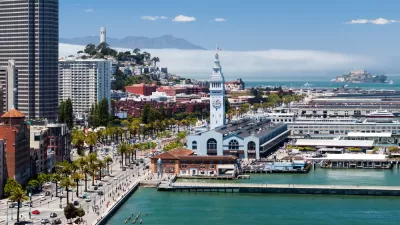As climate change accelerates coastal erosion across the continent, officials everywhere look to San Francisco to see how it will stem the tide, Felicity Barringer reports.
On San Francisco's 3.5-mile-long Ocean Beach, the very same waves that beckon tourists and surfers to the West Coast are slowly chipping the shore away. While erosion "is a perennial issue for beachfront communities," Ocean Beach is especially sensitive: unabated, the encroaching waves threaten to destroy critical infrastructure, including the Great Highway, a wastewater treatment plant, and a 14-foot-wide stormdrain pipe.
It may take some time, but the consequences are expected to be severe, and worsened by rising sea levels due to climate change. "Researchers warned in two new studies that severe coastal flooding could occur regularly in the United States by the middle of the century and that California would be among the states most affected," Barringer notes.
For officials in San Francisco, the options are limited: either reinforce the beach with walls and riprap, build it back up with more sand, or retreat altogether. Stakeholders are divided over these solutions, with each costing on the order of tens of millions of dollars. But a study by the San Francisco Planning and Urban Research Association "projects that sea-level rise there could impose costs of more than $650 million by 2100 if nothing is done."
Barringer summarizes a report by economists at San Francisco State University, writing that "Communities can either plan for the long term or improvise, storm by storm, until ad hoc solutions are inadequate."
FULL STORY: Both Coasts Watch Closely as San Francisco Faces Erosion

Alabama: Trump Terminates Settlements for Black Communities Harmed By Raw Sewage
Trump deemed the landmark civil rights agreement “illegal DEI and environmental justice policy.”

Planetizen Federal Action Tracker
A weekly monitor of how Trump’s orders and actions are impacting planners and planning in America.

The 120 Year Old Tiny Home Villages That Sheltered San Francisco’s Earthquake Refugees
More than a century ago, San Francisco mobilized to house thousands of residents displaced by the 1906 earthquake. Could their strategy offer a model for the present?

In Both Crashes and Crime, Public Transportation is Far Safer than Driving
Contrary to popular assumptions, public transportation has far lower crash and crime rates than automobile travel. For safer communities, improve and encourage transit travel.

Report: Zoning Reforms Should Complement Nashville’s Ambitious Transit Plan
Without reform, restrictive zoning codes will limit the impact of the city’s planned transit expansion and could exclude some of the residents who depend on transit the most.

Judge Orders Release of Frozen IRA, IIJA Funding
The decision is a victory for environmental groups who charged that freezing funds for critical infrastructure and disaster response programs caused “real and irreparable harm” to communities.
Urban Design for Planners 1: Software Tools
This six-course series explores essential urban design concepts using open source software and equips planners with the tools they need to participate fully in the urban design process.
Planning for Universal Design
Learn the tools for implementing Universal Design in planning regulations.
Clanton & Associates, Inc.
Jessamine County Fiscal Court
Institute for Housing and Urban Development Studies (IHS)
City of Grandview
Harvard GSD Executive Education
Toledo-Lucas County Plan Commissions
Salt Lake City
NYU Wagner Graduate School of Public Service




























